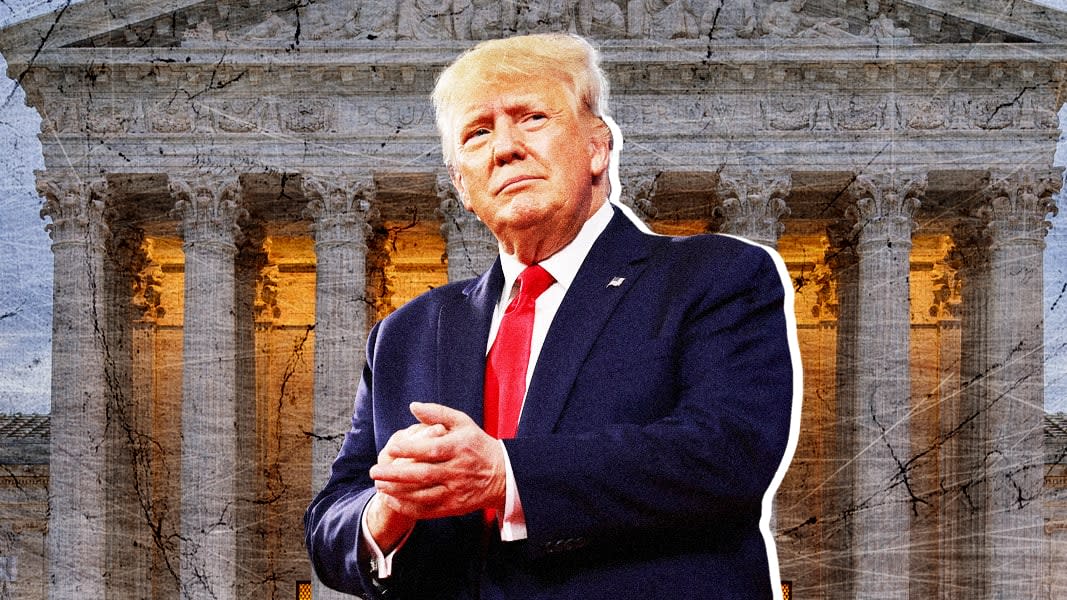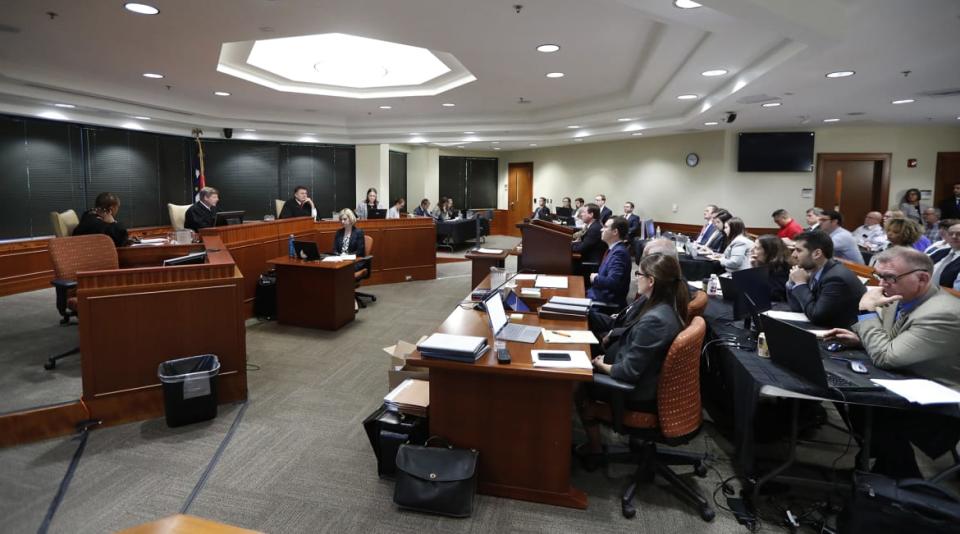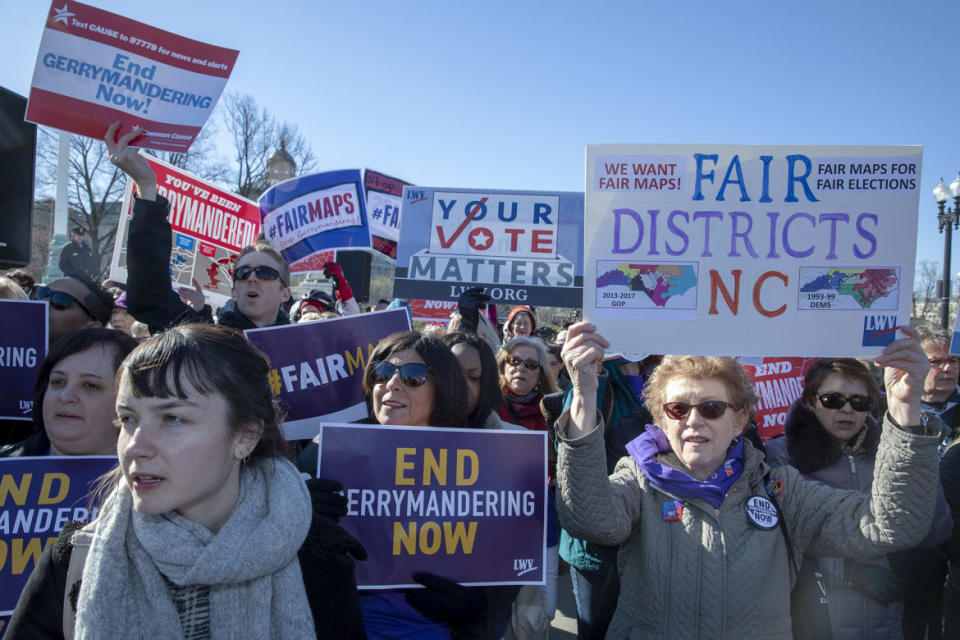Liberal Panic Could Help Trump Steal the Next Election

- Oops!Something went wrong.Please try again later.
Amidst a spate of controversial rulings on topics ranging from abortion to gun rights to environmental regulation, the Supreme Court last month agreed to hear Moore v. Harper, a case that could radically upend election law in the United States, after they reconvene for their October term.
Moore has the potential for a dramatic effect on how the rules for federal elections are set, potentially striking down a host of measures that have been adopted to combat partisan gerrymandering. Also at stake are laws governing voting procedures, such as voter ID laws and early voting—and there’s a serious risk administrative turmoil could ensue.
But in sounding the alarm, a number of media outlets and progressive commentators have propagated a serious misunderstanding with potentially dangerous consequences.
The Most Important SCOTUS Case No One’s Talking About
In an otherwise persuasive criticism in The New York Times, Jamelle Bouie wrote that “this radical interpretation…” would mean “state legislatures could allocate Electoral College votes in any way they see fit, at any point in the process.” In fact, state legislatures can already allocate votes as they see fit, but they can not do so at any point in the process. In particular, they can not do so after Election Day.
This interpretation, and not the doomsaying of the liberal commentariat, is the consensus conclusion among the election law community and people working on the Electoral Count Act.
As both a critic of the theory being advanced in Moore and an advocate of urgently needed reforms to avoid another presidential election crisis, I feel it is important to set the record straight.
In defending democracy against the very real threat of Trump-style subversion, we must get the details right. Crucially, we need to be able to distinguish serious conservative legal scholarship and arguments, even when they are wrong, from worst-case scenarios based on fringe crank theories and total lawlessness. The current majority on the Supreme Court might endorse the former, but we should not concede the latter by falsely conflating the two.
The argument at stake in this case would not mean state legislatures have the power to do what the likes of John Eastman and Peter Navarro proposed in 2020: overturn the results of their state’s presidential election and appoint their own members of the Electoral College in defiance of the will of the voters. That’s a scenario that will still be totally illegal, even if the court gets it wrong in Moore.
Understanding “Independent State Legislature” Theory
To understand what’s not at stake in Moore, we first need to understand what is being argued.
Moore involves North Carolina’s congressional redistricting after the 2020 census. The Republican-controlled state legislature proposed a map heavily skewed in their party’s favor, with ten districts where Donald Trump won more votes in 2020 and only four districts carried by Joe Biden. (Trump narrowly won the state in 2020, 49.9 percent to 48.6 percent).
The North Carolina Supreme Court held that such excessive gerrymandering was impermissible and that the legislature’s map violated the state constitution. Instead, after the legislature failed to adopt a satisfactory map in response, the court drew one of its own making, with eight red seats and six blue seats.

A three-judge panel listens during the first day of the gerrymandering trial challenging the North Carolina legislature district lines on July 15, 2019, at Campbell University's Law School in Raleigh, N.C.
Such back-and-forth fights ending in court-ordered maps are not uncommon. But North Carolina’s legislators raised a new argument, denying that the state Supreme Court has the authority to rule on the matter at all under the “independent state legislature” (ISL) theory.
The ISL theory is based on an ambiguous provision of the U.S. Constitution, which says that “The Times, Places and Manner of holding Elections for Senators and Representatives, shall be prescribed in each State by the Legislature thereof,” subject to possible congressional override.
It’s that word “legislature” that’s at the heart of the matter.
According to ISL proponents, it means state representatives and state senators are directly invested with a power that state constitutions, courts, governors, and voters can’t touch. Only the elected legislative body can set the rules for congressional elections. Thus, the legislature is “independent” of any other state-level constraints.
The counterargument is that state legislatures are creatures of their state constitutions, subject to whatever procedures and rules the state may enact, including things like gubernatorial vetoes, initiatives and referendums, and judicial review by state courts. There are shades of nuance on both sides, with more radical and more moderate interpretations, but that’s the gist of the dispute.
ISL theory has mostly been rejected throughout American history on the rare occasions the argument has even been raised at all. Its alleged originalism is largely ahistorical. From shortly after the ratification of the Constitution to the present day, states have used their constitutions to impose both procedural and substantive rules on how their federal elections are managed. In some states, the power to draw congressional districts has been divested from the legislature altogether and instead given to an independent commission.
Such an independent commission was at the center of the last ISL case to reach the Supreme Court, 2015’s Arizona State Legislature v. Arizona Independent Redistricting Commission. Arizona voters, via ballot initiative, created an independent commission to draw their congressional maps, a popular model adopted in several states as an anti-gerrymandering measure. Legislators sued, but the court upheld the commission in a 5-4 ruling authored by Justice Ruth Bader Ginsburg, joined by Justice Anthony Kennedy and the court’s three other liberals.
Now, of course, the balance of the court has shifted. Ginsburg and Kennedy have been replaced by Amy Coney Barrett and Brett Kavanaugh. In agreeing to hear Moore, it is widely expected that the court is poised to endorse some version of the ISL theory, which conservative justices have been advocating in opinions going back to Bush v. Gore. They’ve never had a majority in favor of ISL before, but now it appears likely (if by no means certain) that they will.
Combined with another recent ruling which held that federal courts can not interfere in partisan gerrymandering, empowering state legislatures in this manner would mean no real check on the practice, which has run rampant in Republican and Democratic states alike. Instead of ballot initiatives and state court rulings, the only remaining option would be to pass a federal law on the topic. That’s a dim prospect in a hyper-partisan Congress where so many members benefit from the status quo.
The ISL theory would also apply to things like voter ID laws and the extent of absentee voting. This could be particularly chaotic because it creates the possibility that the rules for federal elections could diverge from the rules for elections to state offices, even though both appear on the same ballot on the same day.
Administrative chaos and gerrymandering run amok should be alarming enough, but much of the criticism of the court’s potential ruling in Moore focuses elsewhere, on presidential elections.
What Independent State Legislature Theory Is Not
In Trump’s attempt to overturn the 2020 election, one of the most outlandish ideas was cooked up by conservative academic John Eastman. Couched in language superficially similar to ISL theory, Eastman asserted that state legislatures have a plenary power to convene after the election, set aside the results, and appoint slates of Trump electors instead of the Biden electors that had been chosen by voters.

Protesters attends a rally for “Fair Maps” on March 26, 2019, in Washington, D.C.
No state legislature acted on this wild idea. Leaders such as the Arizona House speaker and the governor of Georgia rejected it as flagrantly unconstitutional. Vice President Mike Pence, too, refused to obstruct the joint session of Congress and follow Trump’s demand that he “send [the electoral votes] back to the States” for legislatures to reconsider them.
The superficial similarity of this plan to the ISL theory comes from the Constitution’s Electors Clause, which is phrased similarly to the congressional Elections Clause: “Each State shall appoint, in such Manner as the Legislature thereof may direct, a Number of Electors,” who then meet as the Electoral College and formally elect the next president and vice president.
The power granted to state lawmakers by this provision is very broad, broader even than for congressional elections. The Constitution does not require states to hold popular elections at all to pick their presidential electors. States can, if they want, have the legislature itself choose the members of the Electoral College. Or they could theoretically use any number of other methods, including drawing names out of a hat. But in every state, the longstanding practice has been to give the choice to the voters, who pick from among slates of elector candidates nominated by each party. No state has done it any other way since 1876 and there’s no serious move afoot to change that.
While this power is broad, there is a crucial limit on it. The Constitution also says that, “The Congress may determine the Time of chusing [sic] the Electors.” That time is set by 3 USC §1 as “the Tuesday next after the first Monday in November.” In other words, Election Day.
States have the freedom to decide how their electors will be chosen. They’ve always had that ability and they don’t need ISL theory to invoke it. But what they can’t do—ISL or no ISL—is hold an election, decide they don’t like the results, and only then choose a different method.
Election Day is the inherent deadline for a state to determine how it will choose electors and implement the method chosen. After that, the legislature, however that term is interpreted, plays no further role in the matter. This isn’t a question of constitutional ambiguity or serious dispute: a state can’t decide how it will do something after the time for doing it has already passed.
State legislatures overturning presidential elections in this manner is not a part of the independent state legislature theory as advocated by credible scholars and embraced by at least some conservatives on the Supreme Court. It is, simply put, nonsense that was made up by Eastman and other Trump sycophants in 2020. No judge on any court, anywhere in the country, has ever endorsed it. Nothing about Moore will change that.
To the degree there is any wiggle room on this point, it’s not because of ISL theory. Rather, it’s the unfortunately unclear provision of federal law which covers the possibility of “failed” elections. This provision needs to be reformed as part of an overhaul of the Electoral Count Act. But even as it stands and properly interpreted, it does not give legislatures a blank check to overturn elections whenever they want. Any attempt to invoke it for that purpose would rest on a statutory argument, not ISL theory as a constitutional matter.
But if you’ve followed any of the media coverage and commentary about Moore, you’d easily get the opposite impression. Mainstream outlets and public figures have repeatedly asserted, without any hint of why this is wrong, that the ISL theory is one and the same as Eastman’s crackpot gambit.
Dinesh D’Souza’s Vile Big Lie Documentary Is Too Stupid Even for Fox
This is profoundly unhelpful when Republican state legislators are still resisting pressure to pursue the scheme, and it’s highly possible it will be tried again in 2024. The court will probably embrace ISL theory in some form, which would have real consequences that are serious enough. But the last thing we need is to say this means Trump would now be right about state legislatures having the ability to overturn presidential elections. It wouldn’t.
As Protect Democracy’s Helen White explains, “Although the theory underpinning that effort [to overturn the 2020 election] claimed that state legislators had a gobsmacking amount of power, the independent state legislature theory—even in its most maximalist form—would not give state legislatures the right to veto their voters’ choices.”
Richard Pildes, a leading election law scholar, has also elaborated on the point in more detail: “Even if the Court recognizes an independent state legislature doctrine, such a doctrine would not give state legislatures any new power to appoint electors after the election has been held. [...] The implications of an independent state legislature doctrine are wide-ranging, but that is not one of them.”
Whatever its other faults, the independent state legislature theory would not unleash state legislatures to overturn presidential elections after the fact. Once that choice has been given to voters in an election, their decision is final and the time for doing anything else has passed.
Legislative interference in presidential elections after Election Day will remain unlawful and unconstitutional, and nothing about Moore is poised to change that. Opponents of a repeat attempt of the idea should not inadvertently give ammo to its advocates by incorrectly telling them the Supreme Court has given its stamp of approval.
Get the Daily Beast's biggest scoops and scandals delivered right to your inbox. Sign up now.
Stay informed and gain unlimited access to the Daily Beast's unmatched reporting. Subscribe now.

